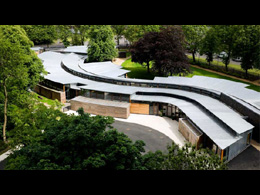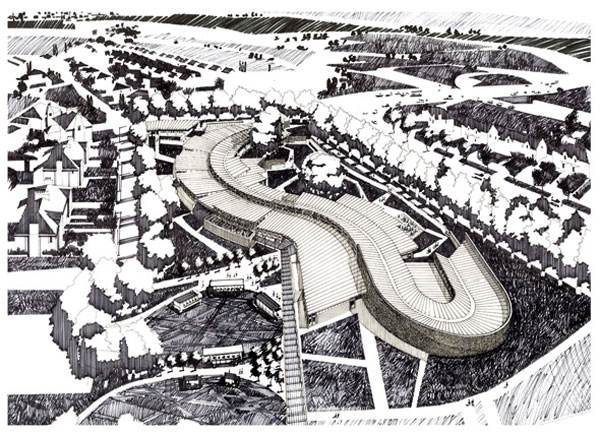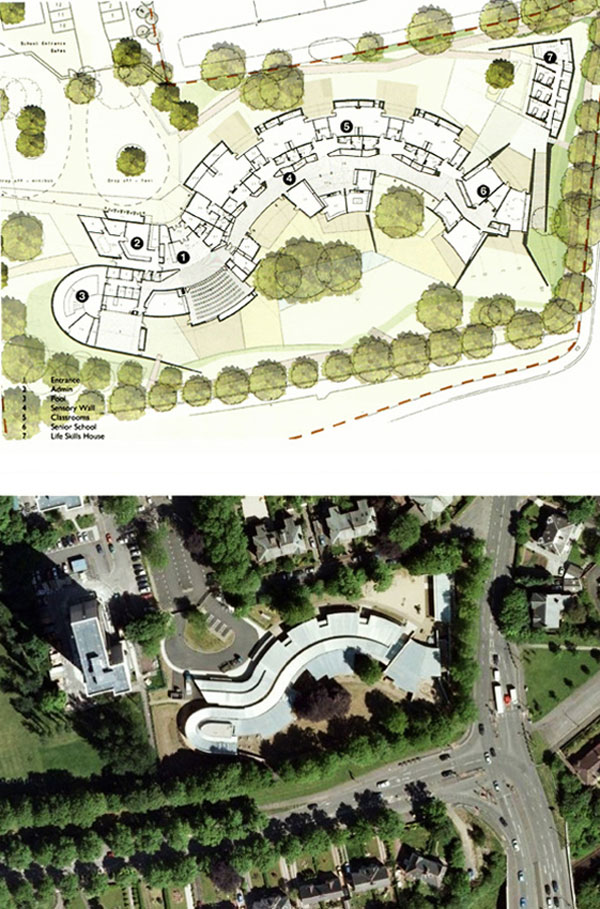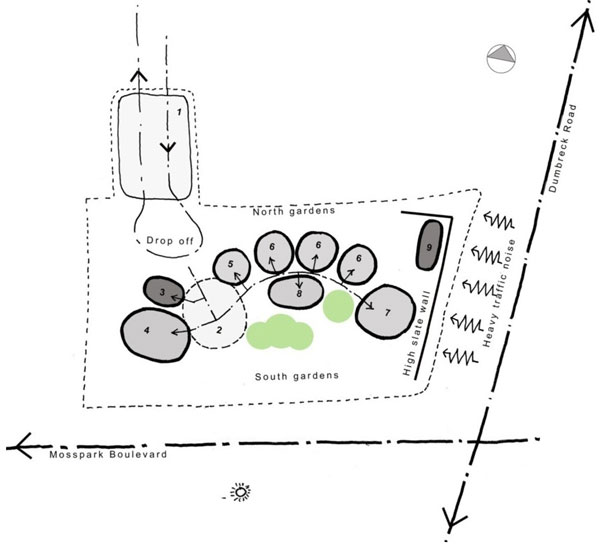ARCHITECTURAL PROJECTS
EDUCATIONAL

01 May, 2011
Independence Spaces - Hazelwood School Glasgow
A school in Scotland for blind and deaf children, a model for collaborative design and process.

" When our children leave this school, they will not go into jobs or go and live in their own flat or house- they will always need to be supported. Adults who are blind and have learning difficulties can lead passive lives. But the more independence they have, the more choices they will be able to make and the more stimulating their lives will be.One young person, the most cognitively challenged person I've ever met, can now go and eat and go to the toilet by himself. For the rest of his life his dignity will be maintained." Monica McGeever: Headteacher
I recently came across a school for blind and deaf children that was completed in 2008 in Scotland and has received several awards and distinctions.
Hazelwood School is designed for children and young people aged 2 to 17 who are blind and deaf with cognitive impairment and physical disabilities. Together they are some of the most severely disabled children in Scotland. The children and young people who attend the school will never be able to lead totally independent lives and will require lifetime support. The project was won in competition by the architect Alan Dunlop and procured under a traditional form of architect commission and building contract.
The school is situated within a strong residential and conservation area to the south of Glasgow and aims to develop pupil's independence through a highly individualised, multi-sensory curriculum which demanded a complex and intricate brief, with even the smallest feature of the building conceived as a learning aid.
The building wraps around mature beech trees and nestles to one side of an adjacent large public park. Classrooms lay along the northern quiet, edge of the site to maximise ambient light and overlook verdant play spaces. To the south, the school steps and curves to create a series of safe and stimulating landscaped teaching gardens. These outside spaces are integral to the teaching practice of the school. It is vital that the children have an accessible external environment, which allows them to breath fresh air, to hear the wind rustling the trees and to feel the rain. These sensory experiences whilst taken for granted by many, form a critical part of a pupil's education.
Ease of orientation within the school is essential to support each child's developing independence. In response to this, the sensory wall was developed in the circulation 'street' as a navigational tool that would allow the children to move around the school safely. The large sculptural units that make up the sensory wall also act as storage units in which mobility-training equipment is kept. The wall is clad in cork, which has a warm tactile quality and provides signifiers along the route to confirm the children's location within the school.The ability to use toilet facilities un-aided offers great independence to the pupils. The location, type, size and fittings of the sanitary facilities have been carefully selected to help educated the students in the variety of toilet types they are likely to come into contact with.
Each one of the external materials was selected for their sensory qualities. The natural larch weatherboarding develops a strong grain when exposed to the elements, offering a gently rippled tactile quality for 'trailing' (navigation using the sense of touch). High level clerestory glazing forms a substantial part of the façade of the north-facing classrooms, allowing for maximum daylight to penetrate deep into the spaces and ensuring even distribution of light. Storage boxes, two and a half metres tall, create a solid wall below the clearstory glazing; this reduces external visual distraction, highlighted by teaching staff as a significant cause of loss of concentration levels in some visually impaired students. Roofing slate hung vertically as cladding has been used to contrast with the timber boarding. Noticeably harder to the touch, the slate walls define external spaces and have the advantage on the south elevations of being a strong heat source, providing another navigation tool for students.
The architect was appointed as 'lead consultant' following a invited competition involving six practices. The client handed the architect the task and freedom to develop an innovative response to a bespoke project type.
One of the most important aspects of the client's involvement was their understanding that the original brief was only an outline description of what was actually required. Due to the complex needs of the user an extended brief development stage was allowed for in the projects design programme. This stage, which included data gathering, site visits, consultations with user & staff, was to last for four months. The research and refinement of requirements that took place during this period was crucial to the creation of an innovative and functional building.
In acknowledgment of the complexity of the buildings requirements the client employed the new Head Teacher for two years prior to the school being scheduled to open. The expense and effort involved in employing a head teacher at such an early stage should be applauded as it undoubtedly ensured a superior final product. The Head Teachers role during this period was to ensure the functionality of the building by way of co-ordinating the interests of the various users and feeding this information to the design team. Experienced in dealing with the schools user group, the Head Teacher also became the architect's day-to-day contact on issues relating to user needs. This was essential during the design process as every design decision from colour choice to furniture design/location was effected by these special needs.
The client also brought on board specialist consultants such as an ophthalmic specials, to discuss the specific effects of certain disabilities. The project was presented to these specialists at various stages of the design to ensure all issues were being taken into account. These meetings helped stimulate discussion and ideas.
Perhaps the most important aspect of the client/architect relationship was the freedom given to the architect to be in continuous contact with those who had experience of the users specific disabilities. This interaction with staff, head teachers and specialist expert gave the architects the opportunity to fully understand the requirements, potentials and restraints of the project.
For both the architect and the client the completed building represents a successful conclusion to an intense four-year design, consultation and construction process, involving parents, teachers, clinicians and the children themselves.



Following this brief description of the project, let us consider some key points in order to discuss some of the concerns raised by the author in earlier texts. Initially, it should be noted that the architect has approached the issue of inclusive design in the wider sense, and not only within a framework of strict utilitarian or prescribed specifications. The synthetic approach has a broader purpose, mentioned above, namely the creation of architectural space that promotes participation, personalization and particularly the personal independence of the students.
Within this context, which epitomises the Stockholm declaration [1] for equality and cultural participation in social activities, the architectural work could not simply be based on an analysis of averages, but rather to explore all the parameters and their harmonious coexistence, in order to establish a school that can be effectively experienced by all. Thus, the intention to "design for all" in this case seems to be implemented effectively through extensive consultations between the architect and a host of other groups involved with the operation of the building and its users. This method adds value to the work since it is not merely the subjective expression of a sterile creator, but rather because the project itself is born from collective needs.
In particular, we should consider two more notable architectural solutions to this collective expression, which seems to quite successfully to fulfill the purpose of the project.
The first refers to the relationship between the building and its surroundings. The building itself is not an object placed neutrally in space. On the contrary, plays a complementary role, such that that building and its surrounding area form a unified landscape. With this decision, the natural and artificial components enter into a dialectical relationship, maximising the input of multi-sensory information to the users. In addition to this, it provides a space full of rich surprises and changing spatial experiences, always in close relationship with the natural realm and its elements. This demonstrates the importance of the natural surroundings and its osmosis with the artificial. The opportunity for discovery and 'ownership' of differing spatial qualities for each individual student is thus multiplied.
The second is the provision of a general, intuitive framework for the creation of space, to ensure the orientation of the senses and cognitive impulses. The organization of the building around a main route is not limited to the visible cork wall. More significantly it acts as an arterial ligature of spaces that always relates to the general directional flows recorded in the cognitive map of the user. The curvature of the system does not change this condition since it is a topological transformation that maintains the relationships between spaces. This simple transformation enriches the spatial experience by using the bends as openings towards natural areas, sometimes introverted, sometimes extroverted. The overall framework is a structure that relates movement to spatial experience.
The most important point, of the latter observation is that this structure becomes a language of communication. The warmest enclosed courtyard is to the south, the northern extroverted yards to the north, the placing of classrooms on the left flank, the transparency of the right flank to the southern yard, and on close inspection, practically all the conditions create a vocabulary communicating the experiential awareness of the space. In an almost structural and educational way, this assemblage of spatial experiences relates to a set of spatial functions, allowing the establishment of a common language according to Saussure [2], which refers to all the senses and cognition through movement. The architecture in this case provides a common code of understanding, ownership and social space among its users.
Thus, Hazelwood School satisfies two basic conditions. Firstly it offers spaces where students may contribute equally. Distinct places where each student is required to discovere, experiencing both the communal and the individual. Moreover, it constructs something even more important: the language and thus the possibility of free expression and communication related to the experience of common space. These two basic conditions help to create a place of independence for all.

Tsabikos Petras Architect Engineer N.T.U.A
Involved with accessibility issues, and the exploration of sensory perception of architectural space.
[1] http://www.designforalleurope.org/upload/design%20for%20all/sthlm%20declaration/stockholm%20declaration_greek.pdf
[2]« The linguistic sign unites not a thing and a name, but a concept and a sound image.The latter is the material sound, a purely physical thing, but the psychic imprint of the sound, the show gives us for this testimony of our senses ..» Saussure, 2006, p.100. In a way, the exhibition of a space as witnessed by the senses is related to its ideal function.]
References
1. F. De Saussure, Writings in General Linguistics, Oxford: Oxford University Press, 2006
2. Stockholm declaration, p.2
The images and the plans are copyrighted by Alan Dunlop Architect Limited.
Awards Hazelwood School:
WAN AWARDS: World Education Building Of The Year 2009 - High Commendation Second Placing
BCSE AWARD
IDA International Design Awards
RIAI Irish Architecture Awards 2009 - Highly Commended
Premio Internazionale Dedalo Minosse Alla Committenza Di Architettura (Selected)
Civic Trust Award
Design Share - Honor Award
G.I.A. Award
World Architecture Festival Awards : Shortlisted
Chicago Athenaeum Museum Of Architecture And Design International Architecture Award
Roses Design And Advertising Award - Best Public Building - Silver
Related articles:
- Music high-school in Plato’s Academy ( 23 June, 2009 )
- ARSAKEIO OF TIRANA GREEKALBANIAN SCHOOL ( 23 June, 2010 )
- ARSAKEIO OF PATRAS ( 15 October, 2009 )
- School of architecture Patra ( 23 July, 2010 )
- Education for production_ School of industrial design engineering on Iera Odos ( 08 April, 2011 )
- Μodel Εducational Unit in Kozani ( 31 January, 2011 )
- Student Residence in Lofos Sikelias Neighborhood ( 02 March, 2011 )
- Experimental educational complex in Tagarades, Thessaloniki ( 03 March, 2011 )
- Tellus Nursery School ( 29 December, 2013 )
- Pio Baroja Nursery, learning from playing ( 07 June, 2014 )
- School center in Ambelokipi (High School - Μidle School) ( 20 March, 2012 )
- Concrete production plant reformation ( 05 April, 2012 )
- Primary school ZV Zavelput ( 14 April, 2012 )
- International architectural competition. Innovative, bioclimatic, European school complexin Crete, Greece ( 03 February, 2013 )
- Nest and flight ( 18 April, 2013 )
- Dance and Music Art Center (DaMAC) in Klafthmonos Square ( 07 July, 2013 )
- Artistic high school near the House for the Elderly in Athens ( 20 September, 2013 )
- Diffuse school in the urban tissue of Patras ( 20 April, 2014 )
- Towards a social school ( 11 November, 2014 )
- Greek High-School, Laniteion ( 17 March, 2015 )
- An alternative music academy ( 25 March, 2015 )










